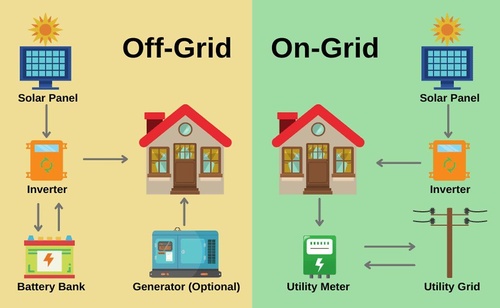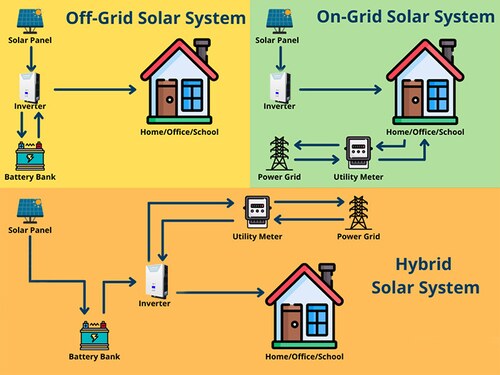As solar energy becomes more popular across Australia, many homeowners and businesses are now facing an important decision: Should you choose an on-grid solar battery system or go completely off-grid?
Both options let you tap into clean, renewable power from the sun, but they work very differently in real life. Their setup, benefits, and ideal use cases vary, especially once you factor in solar batteries.
In this guide, we’ll walk you through the essentials of both systems in simple, practical terms. You’ll learn how they work, what they cost, the pros and cons of each, and how solar batteries can make a big difference depending on the path you choose.
Let’s break it all down so you can make the best decision for your energy needs.
Selecting between an on-grid (grid-connected) and off-grid (standalone) solar + battery system is one of the chief choices Australian homeowners and businesses make when moving to solar energy. Both methods let you use the sun’s power and store energy, but they solve dissimilar problems, come with diverse costs and upkeep demands, and suit unlike lifestyles and locations.
This post breaks down the technical alterations, financial trade-offs, lifestyle impacts, regulatory and incentive considerations (including recent Australian programs), and real-world buying tips so you can choose which path fits your goals.
Comparing On-Grid vs. Off-Grid Solar Battery

Quick Summary — which one suits you?
- On-Grid + Battery: Your rooftop solar connects to the electricity grid. You can export excess solar to earn feed-in credits and significant savings from the grid when desirable. Batteries reduce the amount of imported electricity and help shift solar energy to evening use; the grid leftovers are your backup.
- Off-Grid + Battery: Your system is self-governing of the electricity network. Batteries (often larger) and frequently a generator must cover all demand and provide a reliable supply 24/7. This option is used where grid access is unattainable, unreliable, or when total independence is desired.
Both systems include PV panels, some form of inverter/charger(s) and batteries, but the sizing, cost, and complexity differ a lot.
Key technical differences of On-Grid vs. Off-Grid Solar Battery
1. Grid connection and energy flows
- On-grid: Solar feeds your home first; excess may flow to the grid and earn a feed-in credit. At night or on cloudy days, you import from the grid. Batteries are used to time-shift solar (store daytime spare and discharge in the evening) and deliver limited backup if paired with a suitable backup switch or hybrid inverter.
- Off-grid: All energy must be produced or stored on site. Batteries are sized to convey you through uninterrupted low-sun days (autonomy) and often accompanied by a backup generator for reliability.
2. Equipment differences
- Inverters: On-grid systems use grid-interactive (grid-tie) or hybrid inverters. Off-grid systems necessitate inverters that can manage battery charging, load-sharing, and occasionally multiple phases, often more complex and rugged.
- Battery capacity: Off-grid systems entail much larger usable capacity (kWh) since they must supply all energy requirements with no grid fallback. On-grid homeowners naturally select smaller batteries sized to decrease ultimate import and upsurge self-consumption.
- Control systems & protections: Off-grid installations comprise advanced energy management, automatic generator start/stop, and occasionally load-shedding to prevent blackouts when battery reserves dip. On-grid systems place more emphasis on export limits, tariffs, and security disconnects.
Cost Comparison of On-Grid vs. Off-Grid Solar Battery (installation, ongoing, and replacement)

Upfront costs
- On-grid + battery: Characteristic installed costs for prevalent residential setups (solar + battery) in Australia usually range in the low- to mid-five figures, depending on battery size and brand. After federal/state rebates and existing programs, many homeowners see distinctive installed prices for a 6–10 kWh battery plus a mid-sized solar array in the order of AU$10,000–$20,000 (installed), though prices vary by brand, installer and offers. (Note : Check the latest price with your solar installer)
- Off-grid: Expect considerably higher costs. Because batteries must cover days without sun, you’ll need to multiply the capacity of an on-grid battery, plus a more capable inverter and frequently a backup diesel/petrol generator. Off-grid quotes for whole home systems often run well above an equivalent on-grid system, sometimes 1.5× to 3× the price depending on self-sufficiency requirements and whether a generator is included.
Ongoing costs & maintenance
- On-grid: Lower maintenance, PV panels and battery running with occasional inverter servicing. You still pay grid connection/standing charges and energy for any imported kWh. Batteries degrade over time and will likely involve replacement after 8–15 years, depending on chemistry and usage pattern.
- Off-grid: Higher maintenance and fuel costs for backup generators; more monitoring and perhaps battery replacements sooner because of deeper cycling and larger capacity desires.
Replacement & lifecycle
Battery warranties are critical. Look for 10-year warranties or warranties specified in cycle counts and reserved capacity. Off-grid battery banks may necessitate staged replacements or watchful lifecycle management, increasing lifetime cost.
Financial returns and incentives (Australia, 2024–2025 context)
Feed-in tariffs and exporting
If you’re on-grid, you can export excess solar to retailers for a feed-in tariff (FiT). FiTs vary by state, retailer and plan and have usually fallen in recent years. Many retailers now offer modest cents per kWh rather than high premium rates. That matters because low FiTs upsurge the value proposition of batteries (they let you keep more of your solar for yourself). Check current FiTs with local retailers before sizing a battery.
Government subsidy programs
Australia has newly expanded battery affordability programs. From mid-2025, the federal “Cheaper Home Batteries” program and associated measures have been offering discounts (around 30% in many cases) for eligible small-scale battery installations, and larger grant schemes are obtainable in some states/territories.
There was also a high-profile federal commitment to subsidise household battery uptake in 2025, proposed to lower installed costs meaningfully. These programs essentially progress the economics of on-grid battery systems for numerous homeowners. If you’re considering a system, check eligibility for federal and state programs, as they can decrease upfront costs significantly.
Return on Investment (ROI)
- On-grid with battery: ROI depends profoundly on FiT, retail electricity rates, household load profile and battery size. With low FiTs and high retail rates, batteries that upsurge self-consumption can pay back in the medium term (often 5–12 years, depending on incentives and battery price).
- Off-grid: ROI is not frequently a chief driver; it’s often about avoiding linking expenses, gaining consistency in remote locations, or attaining full independence. In remote areas with high grid connection costs or expensive diesel supply, off-grid systems can make economic sense over time.
Reliability, Resilience and Lifestyle Impact
Reliability
- On-grid: Your grid remains the chief backup. Batteries give you resilience (short outages, topmost shaving, VPP contribution if enabled) but not full freedom unless paired with superior backup switches and further capacity.
- Off-grid: Reliability depends on precise sizing and maintenance. Suitably sized off-grid systems with an auto-start generator can be awfully reliable, but they entail more management and accountable fuel management for generators.
Lifestyle & convenience
- On-grid: Best for homeowners who wish for lower bills, infrequent backup and modest operation. You retain grid convenience (no refuelling or complex generator checks).
- Off-grid: Appeals to remote homeowners, hobby farms, sheds, eco-homesteads and anyone who desires comprehensive independence. It’s more “hands on”, system monitoring, generator maintenance and conservative usage during extended poor solar periods.
Environmental considerations
Off-grid systems that rely profoundly on diesel generators for long periods will have a bigger carbon footprint unless the generator is seldom used. On-grid systems permit excess renewables to feed the grid (which can decrease overall emissions) while batteries maximise local renewable use.
When to Choose on-grid Solar + Battery
Pick on-grid when:
- You have consistent grid access and desire to decrease electricity bills and Evening peaks.
- You wish lower upfront cost and low maintenance.
- You want to contribute to virtual power plants (VPPs) or retailer programs (if accessible).
- You desire the security of the grid as backup rather than a generator.
On-grid is the most mutual residential choice in Australian suburbs and towns, particularly now that battery subsidies and discounts have condensed the upfront barrier for numerous households.
When to Choose Off-grid Solar
Choose off-grid when:
- Grid connection is unobtainable or excessively expensive.
- You want whole independence from the network (e.g., remote house, cabin, farm).
- You accept higher upfront and maintenance costs in exchange for autonomy.
- You are organised to size for extended autonomy and perhaps run a backup generator.
In several rural Australian regions, off-grid is still the applied option. Appropriate design and conservative energy budgeting are vital; under-sizing an off-grid system leads to recurrent generator runs and poor outcomes.
Hybrid & Middle-ground Options
Not everything is binary. Many Australian homeowners opt for hybrid solutions:
- Grid-connected with larger battery + backup switch: Delivers most on-grid benefits plus the ability to detach and run critical circuits during long outages.
- Grid-connected in remote areas with backup generator: Retains the convenience of the grid but delivers local resilience.
- Community microgrids & VPPs: Neighbourhood-scale shared storage or virtual power plants that aggregate home batteries to deliver grid services and conceivable payments.
Clean Energy Council and other industry groups have been pushing rule changes and standards to make connections and hybrid solutions smoother as uptake rises.
Practical Steps for Choosing and Buying
- Audit your electricity use: Recognise your daily and seasonal kWh usage and when you use power (day vs evening). Batteries add more value if you usage lots of electricity after sunset.
- Check local FiTs and retailer plans: If your FiT is higher, transferring solar may be worthwhile; if FiTs are low, batteries are more beneficial. FiTs vary state to state and by retailer.
- Investigate incentives: See if you’re qualified for federal or state battery rebates or discounts? These can change fast (check the Cheaper Home Batteries program and local state schemes).
- Decide autonomy vs budget: If off-grid, outline essential days of autonomy (how many cloudy days you want to cover). More autonomy = larger battery bank = higher cost.
- Get multiple quotes from accredited installers: Aspects for Clean Energy Council-accredited designers and installers ask for modelled savings, degradation assumptions, warranty coverage and replacement costs.
- Check warranty fine print & performance guarantees: Pay attention to usable capacity assurances and cycle/lifetime terms.
- Plan for future-proofing: If you might add an EV, cultivate your household, or join a VPP later, consider a system that can scale or is VPP-capable.
Common Myths & Mistakes
- “Battery always pays back quickly.” Not always. Payback depends on FiT, retail rates, daily load shape, and obtainable subsidies. Crunch the numbers for your household.
- “Off-grid equals zero bills.” Off-grid removes grid bills, but fuel, maintenance, and replacement costs (and higher preliminary capital) can be noteworthy.
- “Any installer will do.” Installer assortment matters, poor design is the most mutual cause of underperforming systems. Use accredited, local, experienced installers for your solar system.
Final Thoughts — which is better for Australia today?
For most Australian urban and suburban households, on-grid with a battery is the best balance of cost, suitability and flexibility. The grid gives consistent backup while batteries rise self-consumption and guard against short outages and high retail rates. Current federal programs and price drops have made batteries more reasonable, improving the economics for numerous homeowners.
Off-grid remains the right choice for remote properties, locations where grid connection is ridiculously expensive, or for people who value total liberation and are relaxed with a more hands-on system and higher lifetime maintenance.
No matter which path you pick, plan sensibly: size your PV and battery to your real needs, check current FiTs and rebates in your state, insist on accredited installers, and read warranty terms closely.
If you want, we can help you build a simple cost vs savings model for your home (we’ll require your location, average monthly kWh usage, and whether you want off-grid autonomy days or are considering on-grid backup).
Here are the FAQs on “On-Grid vs. Off-Grid Solar Battery Systems in Australia” written in clear, user-friendly English:
FAQs on On-Grid vs. Off-Grid Solar Battery Systems in Australia
1. What is the main difference between on-grid and off-grid solar battery systems?
An on-grid system is allied to the electricity grid, permitting you to import power when needed and export excess solar energy. An off-grid system is entirely independent and relies solely on solar panels, batteries, and often a backup generator to meet all power requirements.
2. Which system is cheaper to install in Australia?
On-grid solar with a battery is usually much cheaper to install. Off-grid systems necessitate larger batteries, higher-capacity inverters, backup generators, and a more complex setup, making them meaningfully more expensive.
3. Do both systems work during power outages?
Not all on-grid systems deliver backup during outages. You prerequisite a hybrid inverter and blackout protection to retain crucial circuits running. Off-grid systems, however, work during outages because they are not connected to the main grid.
4. Which system is better for urban and suburban households?
On-grid solar with a battery is frequently the best choice for metro and suburban homes because it lowers bills, requires less maintenance, and uses the grid as backup.
5. When is an off-grid system the better option?
Off-grid systems are perfect for remote or rural locations where grid contact is unavailable or connection costs are awfully high. They are also chosen by people who desire total energy independence.
6. Do on-grid systems still receive feed-in tariffs?
Yes. On-grid systems can earn feed-in tariff (FiT) credits by exporting surplus solar energy to the grid. However, FiTs in Australia have reduced in recent years, making batteries more reasonable.
7. Are off-grid systems eligible for government rebates?
Most Australian rebates and incentives apply to on-grid systems, particularly those connected to Virtual Power Plants (VPPs). Some states may propose support for off-grid installations, but eligibility varies.
8. Which system offers better return on investment (ROI)?
On-grid battery systems naturally offer a faster ROI because you can save on bills, upsurge self-consumption, and benefit from incentives. Off-grid systems emphasise more on independence rather than financial return.
9. How big does the battery need to be for an off-grid setup?
Off-grid homes necessitate much larger battery banks, often sized to support 1–3 days of autonomy during cloudy weather. On-grid systems usually require only enough capacity to cover nighttime consumption.
10. Which system requires more maintenance?
Off-grid systems need regular maintenance, particularly for generators and battery health monitoring. On-grid systems necessitate minimal maintenance and are easier to manage.
11. Can I switch from on-grid to off-grid later?
Yes, but switching later can be costly, as you may be required to replace inverters, add more batteries, and install a generator. It’s best to plan your long-term energy goals upfront.




